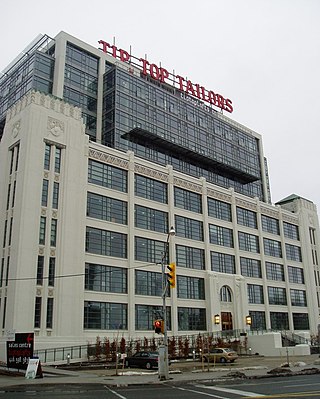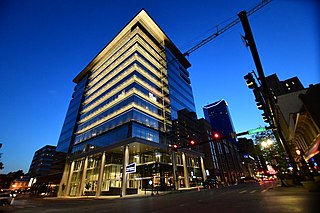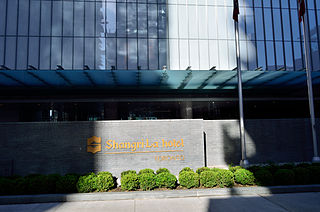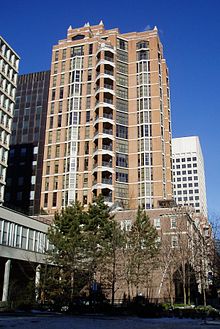
299 Queen Street West, also known as Bell Media Queen Street or Bell Media Studios, is the headquarters of the television/radio broadcast hub of Bell Canada's media unit, Bell Media, and is located at the intersection of Queen Street West and John Street in Downtown Toronto, Ontario, Canada. The building previously served as the headquarters of CTVglobemedia until Bell Canada acquired CTV again in 2011 as well as CHUM Television, a division of CHUM Limited, until CTV acquired CHUM in 2007, and was once known as the CHUM-City Building. It is now head offices and downtown Toronto studios for Bell Media.

The Fairmont Royal York, formerly and still commonly known as the Royal York, is a large historic luxury hotel in Toronto, Ontario, Canada. Located along Front Street West, the hotel is situated at the southern end of the Financial District, in Downtown Toronto. The Royal York was designed by Ross and Macdonald, in association with Sproatt and Rolph, and built by the Canadian Pacific Railway company. The hotel is currently managed by Fairmont Hotels and Resorts.
The Sapphire Tower was a proposed luxury hotel and condominium skyscraper in Toronto, Ontario, Canada, to be built by developer Harry Stinson. It was so named because all plans for it had deep blue glass curtain walls. This site had been involved in numerous other proposals, including Stinson's own Downtown Plaza concept, and an earlier proposal that would have incorporated the neighbouring Graphic Arts Building.

The Omni King Edward Hotel, also known as the "King Eddy", is a historic luxury hotel in Downtown Toronto, Ontario, Canada. The hotel is located at 37 King Street East, and it occupies the entire block bounded by King Street on the north, Victoria Street on the east, Colborne Street on the south and Leader Lane on the west.

The Tip Top Tailors Building, now known as the 'Tip Top Lofts' is a former 1920s industrial building converted to condominium lofts in Toronto, Ontario, Canada. It is located on 637 Lake Shore Boulevard West just west of Bathurst Street, near the waterfront. It was the former headquarters of Tip Top Tailors Ltd., a Canadian menswear retailer.

The Broadview Hotel is a 58 room boutique hotel in Toronto, Ontario, Canada. It is located at the intersection of Broadview Avenue and Queen Street East in Toronto's Riverside neighbourhood. Built in 1893, the building was originally a hall with retail and office space and later converted into a hotel. Until 2014, the establishment was occupied by the New Broadview House Hotel, a hotel and boarding house housing low-income persons with a strip club named Jilly's on its ground level. It was closed and converted to an up-scale establishment with several restaurants and a roof patio.

Downtown Toronto is the main city centre of Toronto, Ontario, Canada. Located entirely within the district of Old Toronto, it is approximately 16.6 square kilometres in area, bounded by Bloor Street to the northeast and Dupont Street to the northwest, Lake Ontario to the south, the Don Valley to the east, and Bathurst Street to the west. It is also the home of the municipal government of Toronto and the Government of Ontario.
Kirk Hyslop was an architect in Toronto, Ontario, Canada. He was born May 1, 1889, in Ontario.

The Studio Building in Toronto, Ontario, Canada, was the home and working studio of several of the Group of Seven painters, their predecessors, and their artistic descendants, and is of enormous significance in the history of Canadian art. The building was designated a National Historic Site of Canada in 2005. It was also designated by the City of Toronto under the Ontario Heritage Act through By-law 115-2003.

The Ford Hotel was a historic hotel in central Toronto, Ontario, Canada. It was one of five hotels in the R.T. Ford & Company hotel chain and was identical to the Ford Hotel, Buffalo and Ford Hotel, Montreal. The 750-room hotel consisted of three 12-story wings connected at the rear by a perpendicular spine atop a one-story base contained the lobby, restaurants and other amenities. The structure was located on Dundas Street West, east of Bay Street. It was built in 1928 and for several decades was one of the city's most prominent hotels. The hotel was next to the Toronto Bus Terminal and provided cheap rooms for lower income travellers. It was also well known as a site for crime and vice. The Toronto Star called it the "rendezvous of choice for couples pursuing an illicit affair."

City Center, formerly known as CentrePointe, is a residential, commercial, and retail building in downtown Lexington, Kentucky that opened in 2020. The plan consists of a 12-story office tower incorporating premium luxury condominiums in its top three floors, two hotels, retail spaces and an underground parking garage. The parking garage was completed in 2017.

Shangri-La Toronto is a luxury hotel and residential condominium building in downtown Toronto, Ontario, Canada. It was designed by James K. M. Cheng and built by Westbank Projects Corp.; they also designed and built the Living Shangri-La in Vancouver. The building is 214 meters tall and is one of the fifteen tallest buildings in Toronto. The hotel component is run by Shangri-La Hotels and Resorts and has 202 guest rooms and suites. The condominium portion occupies the upper floors of the building and consists of 393 units. Excavation of the site started in 2008, and work on the parking garage began in early 2009.

Pinnacle Centre is a condominium tower complex in Toronto, Ontario. The complex consists of four towers located on former railway lands on the Toronto waterfront. It is one of a number of new condominium projects in the area, the most notable being nearby Maple Leaf Square and CityPlace developments to the west. The Pinnacle Centre site is bounded by Yonge Street to the east, Harbour Street to the south, Bay Street to the west, and the Gardiner Expressway to the north. It was built by Vancouver−based Pinnacle International. It has 1,880 residences on approximately 3.8 acres of land.

The Four Seasons Hotel and Residences Toronto is a complex consisting of a 204-metre, 55-storey residential condominium tower and a 125-meter, 30-storey luxury hotel tower in the Yorkville district of Toronto, Ontario, Canada, which opened on October 5, 2012. Located at 60 Yorkville Avenue, at its intersection with Bay Street, the complex is situated one block east of the former Four Seasons Hotel Toronto building at 21 Avenue Road.

The Hotel St. Moritz was a luxury hotel located at 50 Central Park South, on the east side of Sixth Avenue, in Midtown Manhattan, New York City. The structure was extensively rebuilt from 1999 to 2002, and today it is a hotel/condominium combination known as The Ritz-Carlton New York, Central Park.

The Dineen Building is a registered heritage property on Yonge Street, at the corner of Temperance Street, in downtown Toronto, Ontario, Canada. The building was built in 1897, and was extensively renovated in 2012.

The National Hotel was a hotel built on the southeast corner of King and Sherbourne streets, in Toronto, Ontario, Canada. Under pressure for condominium apartment redevelopment, the City of Toronto attempted to preserve the building, designating it a heritage site in 2009, but the building was eventually torn down in 2013. The hotel's north and west facades were preserved as part of the new condominium development, examples of "facadism" in Toronto.

Guild Park and Gardens is a public park in the Scarborough district of Toronto, Ontario, Canada. The park was formerly the site of an artist colony and is notable for its collection of relics saved from the demolition of buildings primarily in downtown Toronto arranged akin to ancient ruins. Located on the Scarborough Bluffs, Guild Park and Gardens has an outdoor Greek stage and a 19th-century log cabin among the oldest in Toronto. The principal building in the park is the Guild Inn, a former inn and estate mansion.
The CIL Building is a fourteen-storey office tower located at 130 Bloor Street West in Toronto, Ontario. Designed by the architectural firm Bregman and Hamann and completed in 1960, the building is one of Toronto's best examples of International Style architecture. The CIL building is best known for its two-storey penthouse, which was originally occupied by businessman Noah Torno and is now a designated historic property.
Janis Kravis was a Latvian architect who established Toronto's first concept store, Karelia, in 1959. A combination café, studio, and retail store, Karelia was a hub for Toronto's mid-century creatives that introduced Marimekko textiles and contemporary Finnish designs to central Canada.
















